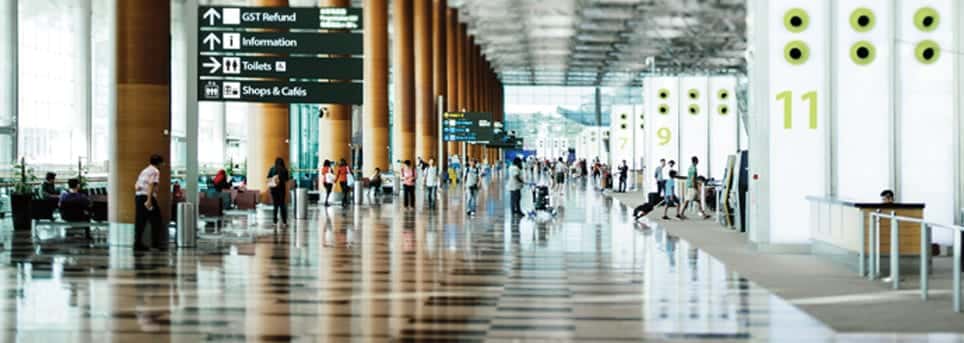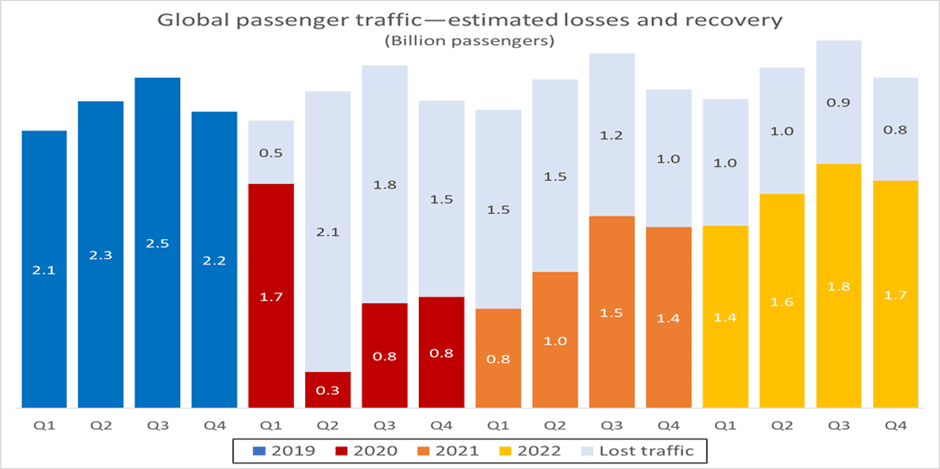
Airports are finally on the path to recovery, albeit the journey may be long and turbulent. Adrian Todd, CEO of AiQ, the award-winning team of operational and analytical experts, believes flight demand will increase in 2022 as predicted. Airport capacity will become constrained, creating operational challenges and opportunities to overcome adversity.
Observing the ACI graph below, recovery during 2022 is expected to follow the upward trend in global passenger traffic seen in Q3 and Q4 of 2021.

ACI forecast a surge in travel in the second half of 2022 with some referring to it as a ‘boom in travel’. These optimistic predictions and the pace of recovery shown above are dependent on factors beyond our control. Strategic operational planning for next year is now needed to address possible capacity constraints and inconsistent flight demand challenges.
‘Working with many worldwide airports during the pandemic we have observed, and assisted operations adapting to our new world. Uncertainty is still ahead for 2022 but not on the scale seen before; airports will need to continue to react and adapt but have greater experience on their side now. More capacity in line with increasing demand next year will be the top operational challenge. We need to ensure the return of resources and key people to achieve the right balance and meet peak demand for the summer months ahead’ Adrian Todd, CEO – AiQ Consulting
Which passengers are likely to return quickly to airports?
Double vaccinated frequent leisure travellers will be the first to board the planes, and families wishing to take their annual summer holiday will be close behind. These passengers will book flights for ideal times creating early morning (7-9am) and evening (6-8pm) peaks. This concentrated demand from a high volume of passengers will create major capacity constraints for airport operations.
Factors causing airport capacity constraints in 2022
Covid has created many complexities and inconsistencies with several factors likely to contribute to capacity challenges next year, especially if demand returns faster than forecasted.
- The high volume of passengers predicted, condensed into peak times
- Additional or changed regulatory Covid processes
- Loss of ‘on the ground’ staff who are security approved and compliant such as PRA/PRM assistants, cleaners, trolley attendees etc
- Loss of experienced airline staff who took early retirement or redundancy
- Reduced airline fleet. Major airlines reduce their fleet to survive the pandemic effects on the industry. Ryanair has warned of a capacity crunch in 2022 with the potential to drive airfares upwards
- Changing government policies
What is the impact on operations?
- Resource inefficiencies are created by short bursts of high demand. Capacity will be expected to increase faster to cover peak levels than overall passenger growth. Matching resource and equipment requirements to cope with peak times could create an idle workforce during off-peak times. However insufficient resources could cause delays and Levels of Service (LoS) implications.
- Immense pressure on existing colleagues and longer queues from insufficient qualified staff. Airports need to recruit, train and security approve people quickly to meet peak demand.
- Queues, delays, and confusion in the passenger journey are caused by varying country vaccination requirements and the need for testing or passenger separation.
Realising capacity to meet peak demand
Flight schedule profiles have been erratic during the pandemic. As a result, resource cutbacks have been made to save costs and loss of revenue. The substantial cost pressures airports face means it’s a careful balance between over and undersupplying of capacity in 2022.
Analysis, demand forecasting, and scenario planning based on flight schedules for peak times will identify optimal capacity required throughout the airport, particularly in terminal and airside vehicles. By clever analysis and ‘what if’ scenarios, operations will have a clear vision in advance, allowing for smart, rapid, and optimised operational decisions. Determining the right level of capacity and resources will ease the pressure on the ground throughout a challenging time.
At AiQ, our award-winning team of operational and analytical experts are dedicated to analysing, modelling, and optimising every aspect of an airport. Specialising in airport capacity, we are trusted to realise capacity and solve complex operational challenges. Read our testimonials.
Our bespoke schedule based Airport Recovery Tool ART is perfect for recovering and inconsistent demand, quickly determining all resource needs from kerbside to runway within 5 minutes.
For more information about how we can assist your capacity challenges in 2022, contact us today.

